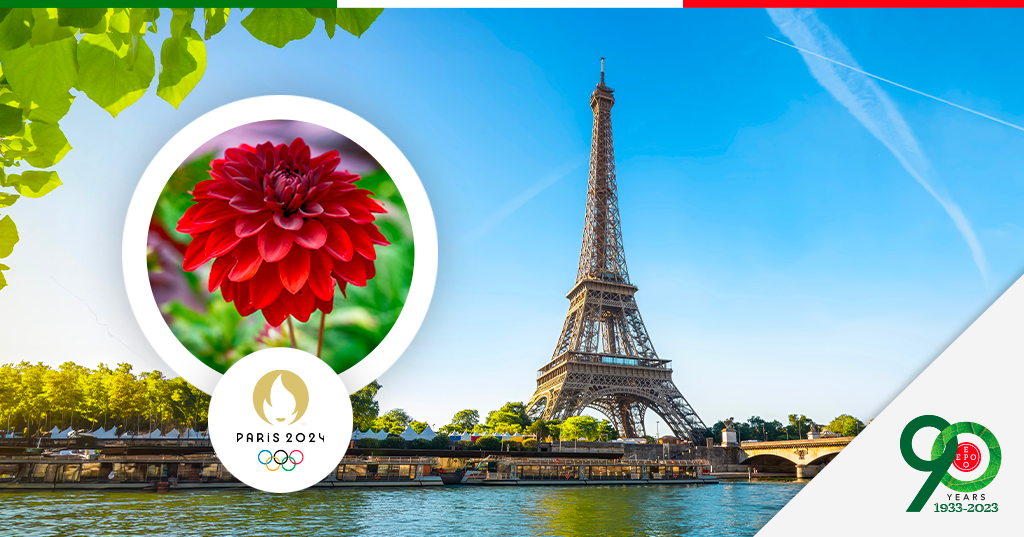
From Paris 2024 to ancient Olympia, the centuries-old link between plants, flowers and the Olympic Games
This summer an unexpected red will blossom in Paris. For the 2024 Olympics, a new flower has been created, the Olympic Games Dahlia, with vibrant red petals like the Olympic flame; this variety was created in the Parc Floral de Paris laboratories to embody the Olympic passion and the emotional link between the Olympic Games and the Ville Lumière. Plants and flowers have always embodied symbolic values; in this article, we will investigate the deep connection between the vegetal world and the Olympic Games.
The flowers of Tokyo 2020 and London 2012 (but not Rio 2016)
One of the features of the Olympic bouquets imposed by the International Olympic Committee (IOC) is that the selected plants must be grown in the host country. During the 2020 Tokyo Olympics (held, however, in 2021 due to the Covid-19 pandemic), the winners received bouquets whose flowers were grown in the northeastern districts of Japan, affected by the 2011 tsunami, and with precise symbolic meanings: from Miyagi, sunflowers planted by parents on the hill where their children had unsuccessfully sought safety from the tsunami; lisianthus from Fukushima, for the hope to recover agriculture after the nuclear disaster; from Iwate, blue gentians, like the logo of Tokyo 2020; aspidistra leaves from Tokyo, as a tribute to the host city.
The 2012 London Olympics Victory bouquets also reflected the colors of the Olympic logo: they were made of roses of four different cultivars, all grown in the UK. An exception to this custom was the 2016 Rio de Janeiro Olympics, when the winning athletes received small sculptures instead of flowers, for a more “sustainable” choice.
Why do the winners of Olympic competitions receive flowers?
Floral homage began with the first modern Olympics in 1896, adopting the Victorian England tradition of celebrating the winners of sports competitions with bouquets. In the 19th century, using symbolic flowers in specific situations was part of a codified non-verbal communication, the so-called “language of flowers” or ‘floriography’.
A tradition dating back to Ancient Greece
During ancient Olympic Games, winning athletes were awarded with symbolic plants. In antiquity, plants were linked to myths, deities, and moral values; Olympia, one of the greatest sanctuaries of ancient Greece, had a special link with Heracles (Hercules), the hero par excellence, who had planted, near the temple of his father Zeus, an olive tree, already mentioned by Theophrastus, the father of botany (4th cent. BC), in his Historia Plantarum, as ‘the wild olive tree of Olympia, from which crowns are made for the games’. The geographer Pausanias (2nd century A.D.) also mentions that Heracles instituted olive-leaf wreaths (kotinos) from this sacred tree as a prize for the winner of the running race, to commemorate Zeus, the king of the gods. The Olympic Games, at that time, were first and foremost a religious and panhellenic event (i.e. involving all the Greek city-states), and an Olympic truce was also instituted to allow athletes and pilgrims to travel safely.
In this regard, Herodotus, in his Histories, tells that the Persian king Xerxes, after the victorious battle of Thermopylae, was astonished that the Greeks preferred to compete in the Olympic Games for an olive wreath instead of fighting ("Good heavens! Mardonius, what kind of men are these against whom you have brought us to fight? Men who do not compete for possessions, but for virtue!”), emphasizing, on the one hand, the moral value of that prize and, on the other, the importance of the Olympic Games and truce.
In addition to the olive tree, a symbol of reconciliation and peace, the winners of the Olympic competitions in Ancient Greece were also offered date palm branches (a symbol of victory), and aromatic garlands of myrtle and laurel (indicating the fame of the victors), and also an apple (for beauty and wisdom).
The Romans continued the tradition of plant wreaths and palm fronds offered to victorious athletes, as shown in the delightful mosaic of the “Maidens wearing a bikini” (Piazza Armerina, Sicily, 4th century A.D.), in which a female athlete winning a sports competition is rewarded by another girl with the palm of victory and a floral crown.
Pierre de Coubertin, John Sibthorp, Ferdinand Bauer and the Olympic Botanical Garden
The merit for renewing the threads with that ancient tradition, more than to Pierre de Coubertin, the founder of the modern Olympics, should be given to John Sibthorp, Professor of Botany at Oxford University, who, in the second half of the 18th century, carried out some botanical expeditions in Greece to collect plants and flowers, later documented by detailed color plates, thanks to his collaboration with the Austrian illustrator Ferdinand Bauer. A titanic work in which the symbolic plants of the ancient Olympic Games were identified; also thanks to this, it is now possible to visit the Olympic Botanical Garden, in the proximity of the archaeological site of ancient Olympia: an open-air museum, housing 58 different species of plants that are representative of the flora of the ancient sacred site, based on ancient descriptions and later testimonies.